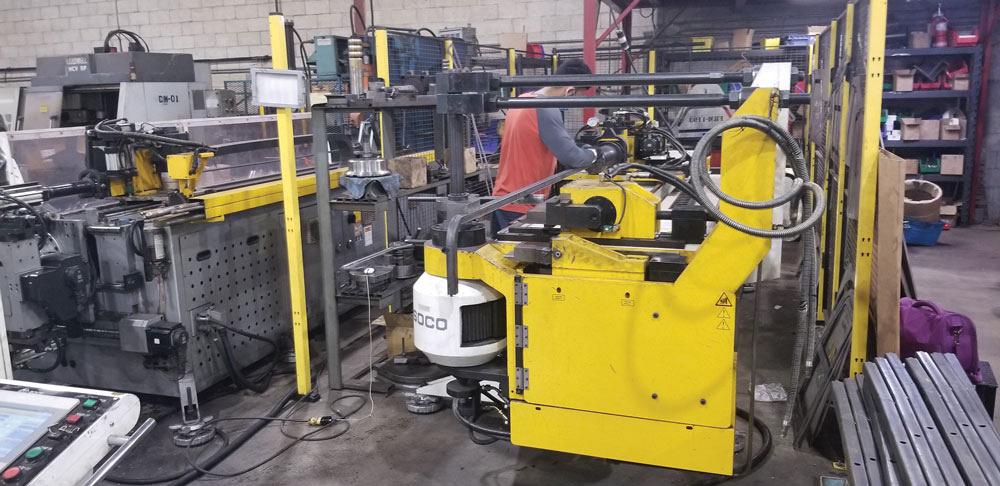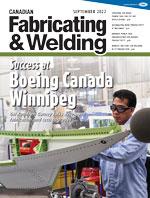Editor
- FMA
- The Fabricator
- FABTECH
- Canadian Metalworking
Automating bend productivity at Millomat
Mississauga job shop increases throughput with bend cell, as well as software, tube investments
- By Rob Colman
- September 19, 2022
- Article
- Automation and Software
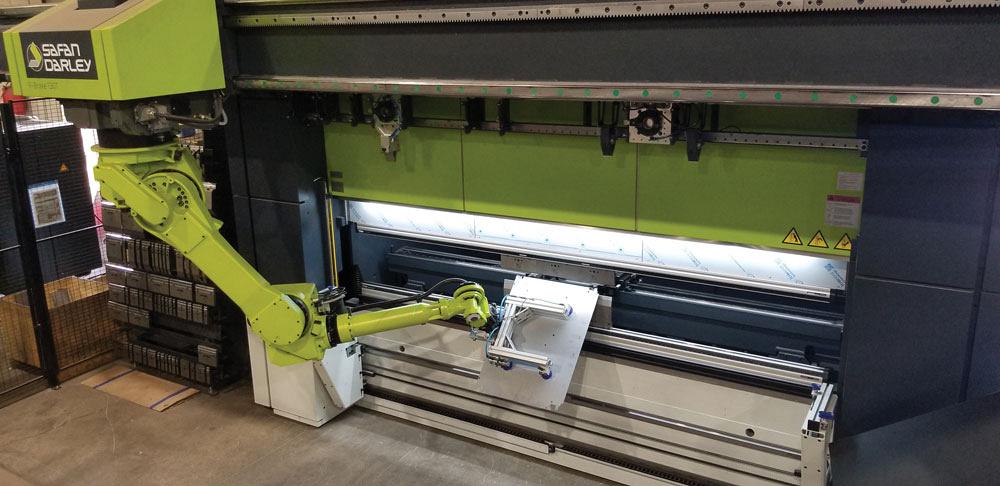
The R-Brake 130T features a robotic arm that moves horizontally along a 6-m long traverse at the top of the press brake. This means that the floor in front of the press brake is free for positioning sheet feed and discharge tables.
Millomat Stampings Inc., Mississauga, Ont., has been pushing its capabilities to increase production speeds and precision for a number of years, investing in new flat sheet and tube lasers and CNC press brakes. Owner Mani Sehmbi is now taking these efforts to the next level, increasing automation to allow for lights-out operations. As a true job shop, doing work for industries from construction to aerospace, it’s a matter of finding which technologies make the most sense.
Adapting to Automation
Sehmbi has already set up two robotic welding bays using older automation technology to speed up assembly processes. The area where he felt he needed the most assistance immediately, however, was in his press brake bay.
In the past few years, the company’s older brakes have been gradually replaced by SafanDarley machines, purchased through Westway Machinery. These have included a 110-ton, 10-ft., 7-axis model for large, complex parts; and a 40-ton model for quick turnaround of smaller parts. Sehmbi is enthusiastic about the company’s technology, so it was no surprised that his first automated brake would also be from SafanDarley.
The system he purchased is the R-Brake 130T, which features a robotic arm that moves horizontally along a 6-m long traverse at the top of the press brake. This means that the floor in front of the press brake is free for positioning sheet feed and discharge tables. Tooling is positioned beside the machine and also is loaded by the robotic arm. The machine comes standard with a positioning table. It also includes a double-sheet detection system to indicate if more than one sheet has been lifted at once.
The value of the machine is obvious for larger, awkward parts—one robot can do the job of two people in a safe and efficient manner. And that is certainly one reason for the investment. But the main reason is the same as so many other shops—employees.
“It’s hard to find and keep people, so this is the direction we need to go in,” said Sehmbi. “With this system, an operator working on another brake will get paged on their cell phone when all the jobs are finished in the cage where the R-Brake runs. That operator can then set up skids for new jobs at the machine and go back to other manual press brake work. All the programming, meanwhile, is done up in the office.”
Sehmbi runs the machine lights out already but adapting to the technology took some time.
“Most issues we’ve had were created by human interference rather than the machine itself, but it’s understanding what issues can potentially come up that is important,” he said. “In one case, we were bending a 45-in.-long, thin-gauge part against two grippers 18 in. apart. Right there, we’ve created our own issue. The part went in crooked and the machine only sensed the one gripper that it was pushing against. To try to reach the second, it pushed the material in harder. With thicker gauge material, it would have levelled up. But because this material was so thin, it was buckling.
“The great thing about SafanDarley’s support is that they worked with us to upgrade the programming to realign thin parts like that in a different way, coming out and shifting the angle until it gets it right,” he continued. “And it does it very quickly.”
In another case, a customer sent Millomat 18-ga. stainless and for some reason there was oil on every part.
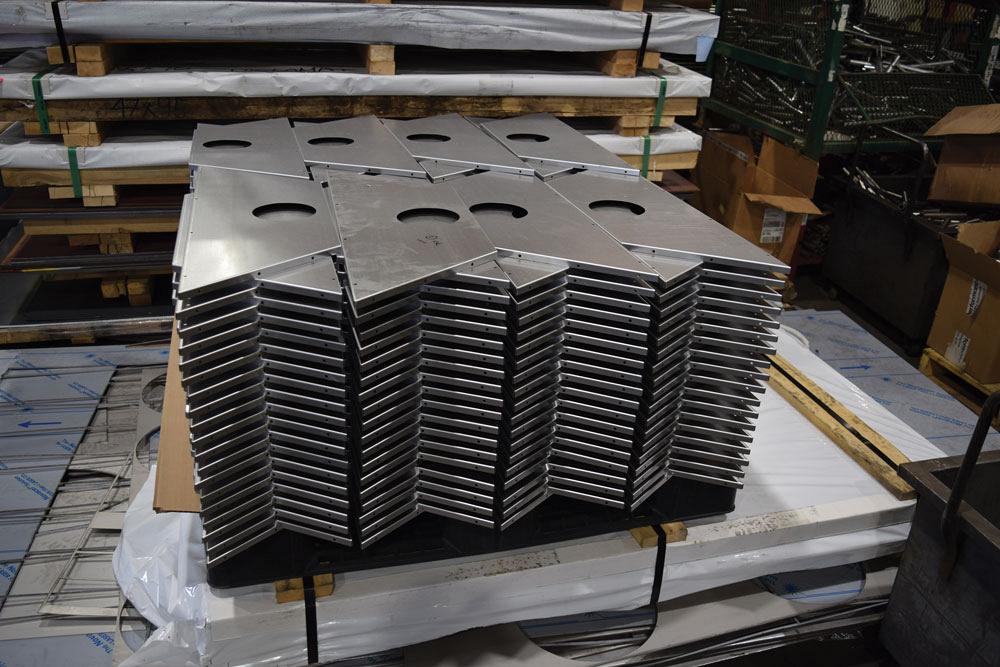
“We now program the brake to run two skids through in each setup, but there’s a room to run as many as four skids of sheet in the cell,” said Mani Sehmbi, owner of Millomat Stampings. “Programming an extra two will be straightforward now that we know how to do two.”
“This created challenges for the gripper and caused parts to stick together,” said Sehmbi. “The robot would recognize these issues and set the parts aside after attempting to process them a couple times, but it’s important to be aware of the condition of the material you’re putting into the machine.”
Sehmbi has yet to reject a part off the machine, and the programming system is intuitive.
“We might adjust a part by a degree after a test run but that’s about it,” he said. “We now program the brake to run two skids through in each setup, but there’s room to run as many as four skids of sheet in the cell. Programming an extra two will be straightforward now that we know how to do two.”
The other benefit of the R-Brake is if, for some reason, an operator has to run a quick manual job on the machine, the job it’s running can be stopped, the robot can be moved out of the way, and a job can be done quickly, manually. Then, the robot can restart the job it was working on previously from where it left off.
The efficiency gains from cell have been substantial.
“Briefly we were able to cut a full shift from our press brake department, but business continues to grow and we’ve since re-established that shift,” said Sehmbi.
ERP Improvements
The R-Brake is one piece of a general shop floor tool upgrade. In addition to that, Millomat introduced ECI JobBOSS in 2021, and two new tube benders.
“The JobBOSS ERP software was a game-changer for us,” Sehmbi said. “My goal is to try to simplify everything in such a way that no matter who in our office quotes a job, our pricing will remain the same. Everything is calibrated with the latest information on material costs and cut feed speeds from the equipment. There’s no guesswork involved. We just pick the material being used on the job and the quantities and it will generate the correct quote.”
The system also allows Sehmbi to see how jobs are being processed, when they are paused, or when operators leave the building.
“We can get an accurate reading of how productive we are, and how that productivity is managed on the floor,” he said.
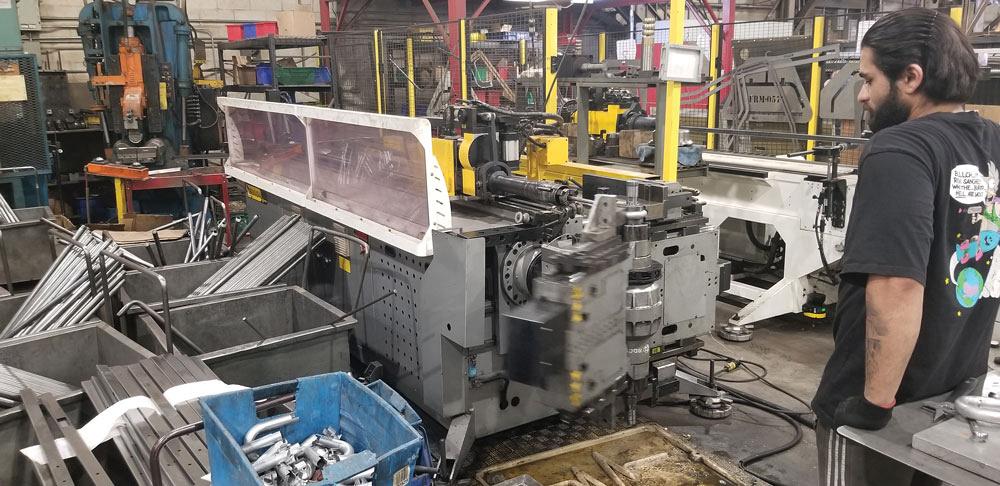
In its tube bending department, Millomat has been running a SOCO SB 32, a left/right machine, and a three-stack right-hand machine. To add to his capabilities, Sehmbi recently purchased a SOCO SB-90AUTO, a 2-axis, NC hydraulic bending machine with capacity up to 3.5 in.
And with customers, it’s possible to organize billing efficiently.
“We might have a customer with an order of 10,000 pieces over a number of months,” he said. “With this, we can arrange that after every 500 pieces a shipment is made and the paperwork gets processed. It simplifies billing processes.”
Dependable Tube Bending
In its tube bending department, Millomat has been running a SOCO SB 32, a left/right machine, and a three-stack right-hand machine. To add to his capabilities, Sehmbi recently purchased a SOCO SB-90AUTO, a 2-axis, NC hydraulic bending machine with capacity up to 3.5 in., also purchased from Westway Machinery.
“I’m bending 3-in. stainless and 14-ga. tubing with that machine,” he said. “Westway is great for getting me the tools I need quickly. This is just another example of that. The SOCO machines are really dependable. I bought my first about 10 years ago and I think I’ve had one service call on it.”
Millomat is in constant motion. By the time this article is in print, work will have started on a 37,000-sq.-ft. expansion of the company’s facility, allowing Sehmbi to improve workflow and shipment processes. At the same time, he’s planning investments in part sorting tech and a new storage system for his flatbed fibre laser cutting machine.
“Further automation investments are important for our future growth,” he said. “I’m trying to determine right now how we can use cobots for part handling in our tube department. The technology is at a place now where I feel confident investing in it. It’s just a matter of getting the right configuration to make it work.”
Editor Robert Colman can be reached at rcolman@canadianfabweld.com.
Millomat Stampings Inc., www.millomat.com
SafanDarley, safandarley.com
SOCO, www.soco.com.tw
Westway Machinery, www.westwaymachinery.com
About the Author

Rob Colman
1154 Warden Avenue
Toronto, M1R 0A1 Canada
905-235-0471
Robert Colman has worked as a writer and editor for more than 25 years, covering the needs of a variety of trades. He has been dedicated to the metalworking industry for the past 13 years, serving as editor for Metalworking Production & Purchasing (MP&P) and, since January 2016, the editor of Canadian Fabricating & Welding. He graduated with a B.A. degree from McGill University and a Master’s degree from UBC.
subscribe now


Keep up to date with the latest news, events, and technology for all things metal from our pair of monthly magazines written specifically for Canadian manufacturers!
Start Your Free Subscription- Trending Articles
BlueForge Alliance partners with Nuts, Bolts & Thingamajigs to develop Submarine Manufacturing Camps

Portable system becomes hot tech in heat treatment

Orbital tube welding webinar to be held April 23

Cidan Machinery Metal Expo 2024 to be held in Georgia May 1-2

Corrosion-inhibiting coating can be peeled off after use

- Industry Events
MME Winnipeg
- April 30, 2024
- Winnipeg, ON Canada
CTMA Economic Uncertainty: Helping You Navigate Windsor Seminar
- April 30, 2024
- Windsor, ON Canada
CTMA Economic Uncertainty: Helping You Navigate Kitchener Seminar
- May 2, 2024
- Kitchener, ON Canada
Automate 2024
- May 6 - 9, 2024
- Chicago, IL
ANCA Open House
- May 7 - 8, 2024
- Wixom, MI













